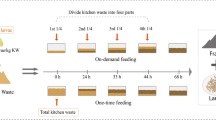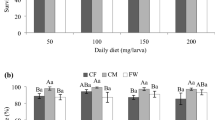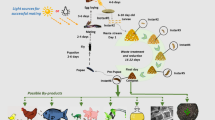Abstract
The exploitation of fast degradation organic solid waste through the use of black soldier fly larvae Hermetia illucens constitutes a promising alternative in waste management given that it generates several products of added value (animal feed, larval compost, biofuels). The proper development of this process and its application at an industrial scale implies knowledge of the load capacity itself. In this context, with the present work the effects of larval density and feeding rate on the bioconversion of organic solid waste were evaluated. A composite central design was used to obtain response surfaces. The results show that both variables have a significant influence on the bioconversion process, with larval density the most influential element. Ideal conditions were determined, within the experiment’s range, to be a larval density of 1.2 larvae/cm2 and a feeding rate of 163 mg/larva/day (dry base) which produces up to 1.1 kg/m2/day of larval compost and 59 g/m2/day of larval biomass, on dry base. In order to generate the most quantity of biomass, the process tolerates larval density values of up to 5 larvae/cm2 without significant influence on the process as long as it is provided with a feeding rate no larger than 95 mg/larva/day (dry base).



Similar content being viewed by others
References
Arango, G. P., Vergara, R. A, Mejía, H.: Análisis composicional, microbiológico y digestibilidad de la proteína de la harina de larvas de Hermetia illucens L (Diptera: Stratiomyidae) en Angelópolis—Antioquia, Colombia. Rev. Fac. Nac. Agron. 57(2) (2004)
St Hilaire, S., Sheppard, D.C., Tomberlin, J.K., Irving, S., Newton, G.L., McGuire, M., Mosley, E., Hardy, R., Sealey, W.: Fly prepupae as a feedstuff for rainbow trout, Oncorhynchus mykiss. J. World. Aquac. Soc. 38, 59–67 (2007)
St Hilaire, S., Cranfill, K., McGuire, M., Mosley, E., Tomberlin, J.K., Newton, G.L., Sealey, W., Sheppard, D.C., Irving, S.: Fish offal recycling by the black soldier fly produces a foodstuff high in omega-3 fatty acids. J. World. Aquac. Soc. 38, 309–313 (2007)
Choi, Y.C., Choi, J.Y., Kim, J.G., Kim, M.S., Kim, W.T., Park, K.H., Bae, S.W., Jeong, G.S.: Potencial usage of food waste as a natural fertilizer after digestion by Hermetia illucens (Diptera: Stratiomyidae). Int. J. Ind. Entomol. 19, 171–174 (2009)
Agrawal, N., Chacko, M., Ramachandran, M., Thian, M.: Assessing the commercial viability of BSF as biodiesel & animal feed, University of California berkeley haas school of business, London School of Hygiene and Tropical Medicine (2011)
Li, Q., Zheng, L., Cai, H., Garza, E., Yu, Z., Zhou, S.: From organic waste to biodiesel: black soldier fly, Hermetia illucens, makes it feasible. Fuel 90, 1545–1548 (2011). doi:10.1016/j.fuel.2010.11.016
Zheng, L., Li, Q., Zhang, J., Yu, Z.: Double the biodiesel yield: Rearing black soldier fly larvae, Hermetia illucens, on solid residual fraction of restaurant waste after grease extraction for biodiesel production. Renew. Energy. 41, 75–79 (2011). doi:10.1016/j.renene.2011.10.004
Jeon, H., Park, S., Choi, J., Jeong, G., Lee, S., Choi, Y., Lee, S.: The intestinal bacterial community in the food waste-reducing larvae of Hermetia illucens. Curr. Microbiol. 62, 1390–1399 (2011). doi:10.1007/s00284-011-9874-8
Kim, W., Bae, S., Park, K., Lee, S., Choi, Y., Han, S., Koh, Y.: Biochemical characterization of digestive enzymes in the black soldier fly, Hermetia illucens (Diptera: Stratiomyidae). J. Asia Pac. Entomol. 14, 11–14 (2011). doi:10.1016/j.aspen.2010.11.003
Myers, H.M., Tomberlin, J.K., Lambert, B.D., Kattes, D.: Development of black soldier fly (Diptera: Stratiomyidae) larvae fed dairy manure. Environ. Entomol. 37, 11–15 (2008)
Newton, L., Sheppard, C., Watson, D.W., Burtle, G., Dove, R.: Using the black soldier fly, Hermetia illucens, as a value-added tool for the management of swine manure. Waste management programs. North Carolina state university (2005)
Diener, S., Studt Solano, N.M., Roa Gutiérrez, F., Zurbrügg, C., Tockner, K.: Biological treatment of municipal organic waste using black soldier fly larvae. Waste Biomass Valoriz. 2, 357–363 (2011). doi:10.1007/s12649-011-9079-1
Sheppard, D.C., Tomberlin, J.K., Joyce, J.A., Kiser, B.C., Sumner, S.M.: Rearing methods for the black soldier fly (Diptera: Stratiomyidae). J. Med. Entomol. 39, 695–698 (2002)
Diener, S., Zurbrügg, C., Tockner, K.: Conversion of organic material by black soldier fly larvae: establishing optimal feeding rates. Waste Manag. Res. 27, 603–610 (2009). doi:10.1177/0734242X09103838
Mihelcic, J.: Fundamentos de Ingeniería Ambiental. Editorial Limusa, Mexico (2008)
SSPD—Superintendencia de Servicios Públicos Domiciliarios: Informe nacional de disposición final. Diagnóstico 2012. (2012)
IDEAM—Instituto de Hidrología Meteorología y Estudios Ambientales: Capítulo seis. Módulo de Residuos. Inventar. Nac. fuentes y sumideros gases Ef. Invernadero (2009)
Sakurai, K.: HDTHDT 17: Método sencillo de análisis de residuos sólidos. In: Hojas Divulg. técnica CEPIS. http://www.bvsde.paho.org/eswww/proyecto/repidisc/publica/hdt/hdt017.html (2000). Accessed 02 June 2014
Scriber, J. M., Slansky, F.: The nutricional ecology of immature insects. Annu. Rev. Entomol. 26, 183–211 (1981)
Ohaus Corporation: Manual de instrucciones analizador de humedad MB45. (2011)
Arica, M.: Biological Treatment of Leachates of Microaerobic Fermentation, p. 78. Portland State University, Portland (2012)
Olivier, P.: The On-site Recycling of Food Residuals, pp. 1–7. Engineering, Separation & Recycling LLC, Washington D.C (2004)
Gobbi, F.P.: Biología reproductiva y caracterización morfológica de los estadios larvarios de Hermetia illucens (L., 1758) (Diptera: Stratiomyidae). Bases para su producción masiva en Europa. Universidad de Alicante, Alicante (2012)
Acknowledgments
The authors wish to thank the Universidad del Valle, the Vicerectoria de Investigaciones for funding the project “Evaluación de un modelo piloto de bioconversión de residuos sólidos orgánicos usando larvas de la mosca soldado negra Hermetia illucens (L.), (Diptera: Stratiomyidae)” (Evaluation of a pilot model for bioconversion of organic solid waste using black soldier fly larvae) (C.I-7906), to COLCIENCIAS and the Jovenes Investigadores e Innovadores Program “Virginia Gutiérrez de Pineda”. They also thank the Chemical Engineering and Biology Labs of the Universidad del Valle, as well as the University Restaurant, the fruit stands and the shopping center Unicentro for supplying the waste.
Author information
Authors and Affiliations
Corresponding author
Rights and permissions
About this article
Cite this article
Parra Paz, A.S., Carrejo, N.S. & Gómez Rodríguez, C.H. Effects of Larval Density and Feeding Rates on the Bioconversion of Vegetable Waste Using Black Soldier Fly Larvae Hermetia illucens (L.), (Diptera: Stratiomyidae). Waste Biomass Valor 6, 1059–1065 (2015). https://doi.org/10.1007/s12649-015-9418-8
Received:
Accepted:
Published:
Issue Date:
DOI: https://doi.org/10.1007/s12649-015-9418-8




